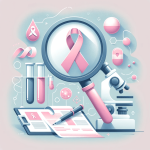This enlightening article delves into the latest advancements in breast cancer drugs, offering hope and improved quality of life for millions affected worldwide. It begins by explaining breast cancer’s biology, including its types and risk factors, setting the stage for understanding the evolution of treatment options. The article highlights the transition from traditional methods like surgery to modern approaches such as radiation, chemotherapy, and groundbreaking targeted therapies. Emphasizing the role of personalized medicine, it shows how treatments are now tailored to individual genetic profiles for more effective outcomes. With ongoing research and trials, the future of breast cancer treatment looks promising, with potential breakthroughs in immunotherapies and gene therapies on the horizon. This comprehensive guide is a beacon of hope, showcasing how continuous medical advancements are transforming the fight against breast cancer, making it an essential read for anyone touched by the disease.
Breast cancer is a disease that affects millions of women around the world. Fortunately, medical research has led to significant breakthroughs in the field of breast cancer drugs. These advancements have not only improved survival rates but have also increased the quality of life for those undergoing treatment. In this article, we will explore the latest breakthroughs in breast cancer drugs and their impact on the lives of patients and their loved ones.
Understanding Breast Cancer: A Brief Overview
Breast cancer is a complex disease that develops when cells in the breast begin to grow uncontrollably. It can occur in both men and women, although it is much more common in women. To better understand the breakthroughs in breast cancer drugs, it is essential to familiarize ourselves with the biology and types of breast cancer.
The Biology of Breast Cancer
At the core of breast cancer is a disruption in the normal growth cycle of breast cells. Mutations in certain genes, such as BRCA1 and BRCA2, can increase the risk of developing the disease. These genes are responsible for repairing damaged DNA and maintaining the stability of the cell’s genetic material. When mutations occur in these genes, the cell’s ability to repair DNA is compromised, leading to the accumulation of genetic abnormalities and the development of cancer.
In addition to genetic mutations, breast cancer can also be influenced by various factors, including age, family history, and lifestyle choices. Advanced age is a significant risk factor for breast cancer, with the majority of cases occurring in women over the age of 50. Family history of breast cancer, especially in first-degree relatives, can also increase the risk of developing the disease. Lifestyle choices, such as smoking, excessive alcohol consumption, and a sedentary lifestyle, have been associated with an increased risk of breast cancer.
Furthermore, hormonal factors play a crucial role in the development of breast cancer. Estrogen, a hormone that regulates the growth and development of breast tissue, can promote the growth of cancer cells when present in high levels. This is why early menstruation, late menopause, and the use of hormone replacement therapy are considered risk factors for breast cancer.
Types of Breast Cancer
There are several types of breast cancer, each with its own characteristics and treatment approaches. Ductal carcinoma in situ (DCIS) is a non-invasive type of breast cancer where abnormal cells are confined to the milk ducts. While DCIS is not life-threatening, it can progress to invasive breast cancer if left untreated.
Invasive ductal carcinoma is the most common type of breast cancer, accounting for about 80% of all cases. It begins in the milk ducts but can spread to surrounding breast tissue. Invasive ductal carcinoma can also metastasize to other parts of the body, such as the lymph nodes, liver, lungs, or bones.
Invasive lobular carcinoma is less common, accounting for about 10% of all breast cancer cases. It starts in the lobules, which are the milk-producing glands of the breast. Invasive lobular carcinoma can also spread to other parts of the body and is more difficult to detect on mammograms compared to invasive ductal carcinoma.
Other less common types of breast cancer include inflammatory breast cancer, which is characterized by redness and swelling of the breast, and triple-negative breast cancer, which lacks estrogen receptors, progesterone receptors, and HER2 protein. These types of breast cancer require specialized treatment approaches tailored to their unique characteristics.
The Evolution of Breast Cancer Treatments
Over the years, breast cancer treatments have evolved significantly. What once seemed like an insurmountable obstacle has now become a battle that can be fought with an array of effective therapies.
Early Methods of Treatment
In the past, surgery to remove the tumor was the primary method of treating breast cancer. While this approach is still utilized today, it is often coupled with additional treatment modalities to maximize effectiveness.
Modern Treatment Approaches
The advent of modern medicine has brought about groundbreaking advancements in breast cancer treatment. Radiation therapy, chemotherapy, targeted therapies, and immunotherapy have become the pillars of modern breast cancer care. These treatments have improved survival rates and allowed many patients to lead fulfilling lives during and after treatment.
New Generation of Breast Cancer Drugs
Recent breakthroughs in breast cancer drugs have revolutionized the way we approach treatment. These drugs target specific molecules and pathways involved in the growth and spread of cancer cells, leading to better outcomes for patients.
Mechanism of Action
The new generation of breast cancer drugs works by interfering with the signaling pathways that cancer cells rely on to survive and proliferate. They may target hormone receptors, such as estrogen and progesterone receptors, or block the action of specific proteins, such as HER2.
Benefits Over Traditional Treatments
Compared to traditional treatments, the new generation of breast cancer drugs offers several advantages. They are often better tolerated, with fewer side effects and less impact on healthy cells. Additionally, these drugs can be more effective in certain patient populations, leading to improved outcomes and a higher quality of life.
The Role of Personalized Medicine in Breast Cancer
Personalized medicine has emerged as a game-changer in breast cancer treatment. It recognizes that each patient is unique and tailors treatment strategies to their specific needs, resulting in better outcomes and reduced side effects.
The Concept of Personalized Medicine
Personalized medicine takes into account an individual’s genetic makeup, lifestyle choices, and tumor characteristics to develop targeted treatment plans. By understanding the unique aspects of each patient’s cancer, healthcare providers can make informed decisions regarding the most effective therapies.
Personalized Medicine in Breast Cancer Treatment
In breast cancer, personalized medicine has enabled clinicians to identify specific genetic alterations that drive tumor growth and recommend targeted therapies. For example, patients with HER2-positive breast cancer can benefit from drugs that specifically block the overexpression of HER2, improving their chances of successful treatment.
Future Prospects in Breast Cancer Drug Development
While we have made incredible progress in the field of breast cancer drugs, the research efforts continue to pave the way for even more breakthroughs. Ongoing research and clinical trials are exploring new treatment options, with the aim of further improving patient outcomes.
Ongoing Research and Trials
Scientists and pharmaceutical companies are actively studying novel drugs that show promise in breast cancer treatment. These drugs target different pathways and utilize innovative approaches, such as immune-enhancing therapies and combination treatments. Clinical trials play a vital role in assessing their safety and efficacy before they can be widely available.
Potential Breakthroughs on the Horizon
Exciting breakthroughs in breast cancer drug development are on the horizon. New immunotherapies, targeted therapies, and gene therapies are being explored, showing great potential in improving treatment outcomes. While there is still work to be done, the future looks bright for those battling breast cancer.
In conclusion, the latest breakthroughs in breast cancer drugs have given hope to millions of women and their families. With a deeper understanding of the biology of breast cancer and the advent of innovative treatments, we are making significant strides in improving patient outcomes and the overall management of the disease. As we move forward, continued research and advancements in personalized medicine hold immense promise for a future free from the burden of breast cancer.






